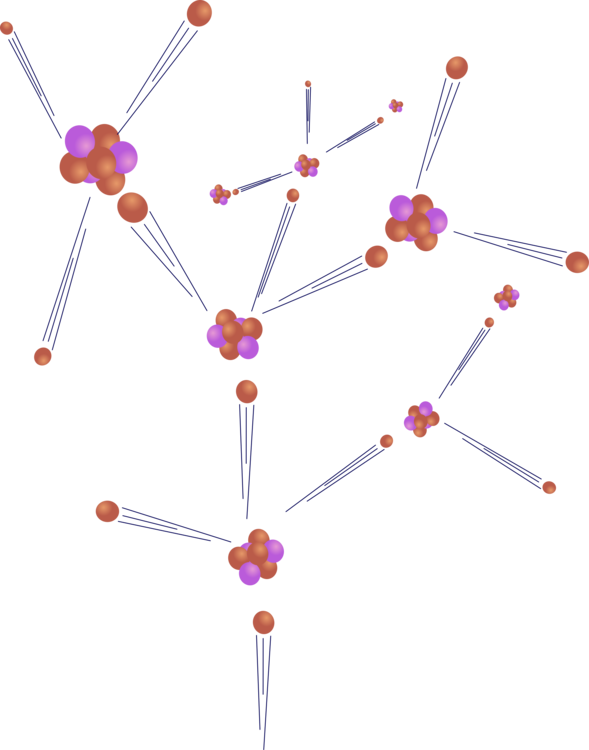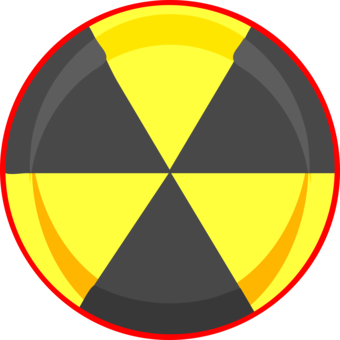Nuclear reactions
Nuclear reactions
In a generic sense, a nuclear reaction is any process in which an atomic nucleus is transformed to produce another nucleus of a different nature. The general scheme of a nuclear reaction is as follows:
a + X --> Y + b + Q

kissCC0
where X is the initial atomic nucleus, Y is the final nucleus, a type of particle with which the nucleus X is bombarded, and b is the particle or particles resulting from the reaction. The term Q is the energy balance produced as a result of the reaction.
The value of the energy balance of a nuclear reaction can be positive, in which case the reaction is called exoenergetic, or negative, when more energy is consumed than is released, in reactions called endoenergetic.
In the first nuclear reaction induced by artificial means (carried out in 1932), lithium atoms of mass number 7 were bombarded with very energetic protons to produce alpha particles (nuclei of helium 4).

KisCC0
Types of nuclear reactions
In essence, two types of nuclear reactions can be distinguished:
Nuclear fission: a reaction in which a relatively heavy atom is broken down into lighter atoms in a reaction that is usually accompanied by the emission of radioactive particles and the production of large amounts of energy. This reaction is common in the manufacture of nuclear bombs and is the one induced in current nuclear power plants to obtain electrical energy. It can cause environmental problems deriving from the need to transport and store the hazardous radioactive waste that it produces and leads to strict safety controls.
Nuclear fusion: that in which two light cores are joined to form a heavier one. This type of reaction takes place inside the stars (in so-called thermonuclear reactions) and gives them their brightness and energy production. On a terrestrial scale, experiments on nuclear fusion face a major problem: the difficulty of controlling the enormous amounts of energy handled in the process. However, it is considered to be the energy source of the future, as it does not produce hazardous radioactive waste and could be obtained from fuels as economical as deuterium (hydrogen 2) from seawater.
Nuclear fission
The first nuclear reaction in human history was nuclear fission. This process consists, strictly speaking, in the decomposition of a heavy nucleus into two other nuclei of mass and atomic number approximately equal to half of the original nucleus. The starting atoms in nuclear fission processes are uranium 235 (a rare isotope of uranium, present in 1/140 parts in its natural ores) and plutonium.
Fission reactions are very exoenergetic, and their first historical use occurred in the atomic bomb that fell on Hiroshima (Japan) at the end of World War II. Today, nuclear fission is used for civil purposes (nuclear power plants), transport (nuclear propulsion) and military purposes (atomic weaponry). The first self-sustaining fission reaction was achieved in 1942 at the University of Chicago, thanks to the work of the team at this centre directed by the Italian-born physicist Enrico Fermi (1901-1954).
Nuclear fusion
The process of nuclear fusion is conceptually inverse to that of fission. In fusion, two light nuclei join together to form a heavier atom. The energy yield of fusion reactions is much higher than that of fission reactions. In terms of energy per nucleon, 0.74 MeV is produced in fission, while in fusion reactions this figure rises to 3.52 MeV.
The most typical form of nuclear fusion reaction is the conversion of two hydrogen nuclei (one of deuterium, or hydrogen 2, and another of tritium, or hydrogen 3) into one of helium, with the emission of a neutron and a very high amount of energy.
Nuclear fusion, in various reactive chains (proton-proton and carbon cycle), is the source of energy for stars.
Hello @apvk, thank you for sharing this creative work! We just stopped by to say that you've been upvoted by the @creativecrypto magazine. The Creative Crypto is all about art on the blockchain and learning from creatives like you. Looking forward to crossing paths again soon. Steem on!
Thank you! It is amazing!!
Sneaky Ninja Attack! You have just been defended with a 11.76% upvote!
I was summoned by @apvk. I have done their bidding and now I will vanish...
woosh
A portion of the proceeds from your bid was used in support of @youarehope and @tarc.
Abuse Policy
Rules
How to use Sneaky Ninja
How it works